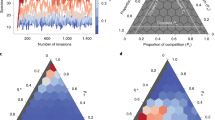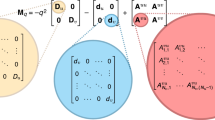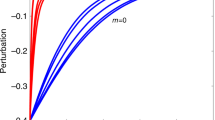Abstract
Rich ecosystems harbour thousands of species interacting in tangled networks encompassing predation, mutualism and competition. Such widespread biodiversity is puzzling, because in ecological models it is exceedingly improbable for large communities to stably coexist. One aspect rarely considered in these models, however, is that coexisting species in natural communities are a selected portion of a much larger pool, which has been pruned by population dynamics. Here we compute the distribution of the number of species that can coexist when we start from a pool of species interacting randomly, and show that even in this case we can observe rich, stable communities. Interestingly, our results show that, once stability conditions are met, network structure has very little influence on the level of biodiversity attained. Our results identify the main drivers responsible for widespread coexistence in natural communities, providing a baseline for determining which structural aspects of empirical communities promote or hinder coexistence.
This is a preview of subscription content, access via your institution
Access options
Access Nature and 54 other Nature Portfolio journals
Get Nature+, our best-value online-access subscription
$29.99 / 30 days
cancel any time
Subscribe to this journal
Receive 12 digital issues and online access to articles
$119.00 per year
only $9.92 per issue
Buy this article
- Purchase on Springer Link
- Instant access to full article PDF
Prices may be subject to local taxes which are calculated during checkout



Similar content being viewed by others
References
Lotka, A. J. Elements of Physical Biology (Williams & Wilkins, Baltimore, MD, 1925).
Volterra, V. Fluctuations in the abundance of a species considered mathematically. Nature 118, 558–560 (1926).
Kingsland, S. Alfred J. Lotka and the origins of theoretical population ecology. Proc. Natl Acad. Sci. USA 112, 9493–9495 (2015).
Pascual, M. & Dunne, J. A. Ecological Networks: Linking Structure to Dynamics in Food Webs (Oxford Univ. Press, Oxford, 2006).
May, R. M. Will a large complex system be stable? Nature 238, 413–414 (1972).
Goh, B. S. Global stability in many-species systems. Am. Nat. 111, 135–143 (1977).
Sigmund, K. Darwin’s “circles of complexity”: assembling ecological communities. Complexity 1, 40–44 (1995).
Rohr, R. P., Saavedra, S. & Bascompte, J. On the structural stability of mutualistic systems. Science 345, 1253497 (2014).
Grilli, J. et al. Feasibility and coexistence of large ecological communities. Nat. Commun. 8, 14389 (2017).
Grilli, J., Barabás, G., Michalska-Smith, M. J. & Allesina, S. Higher-order interactions stabilize dynamics in competitive network models. Nature 548, 210–213 (2017).
Levine, J. M., Bascompte, J., Adler, P. B. & Allesina, S. Beyond pairwise mechanisms of species coexistence in complex communities. Nature 546, 56–64 (2017).
Roberts, A. The stability of a feasible random ecosystem. Nature 251, 607–608 (1974).
Goh, B. S. & Jennings, L. S. Feasibility and stability in randomly assembled Lotka–Volterra models. Ecol. Modell. 3, 63–71 (1977).
Drake, J. A. The mechanics of community assembly and succession. J. Theor. Biol. 147, 213–233 (1990).
Brose, U., Williams, R. J. & Martinez, N. D. Allometric scaling enhances stability in complex food webs. Ecol. Lett. 9, 1228–1236 (2006).
Otto, S. B., Rall, B. C. & Brose, U. Allometric degree distributions facilitate food-web stability. Nature 450, 1226–1229 (2007).
Williams, R. J. Effects of network and dynamical model structure on species persistence in large model food webs. Theor. Ecol. 1, 141–151 (2008).
Stouffer, D. B. & Bascompte, J. Compartmentalization increases food-web persistence. Proc. Natl Acad. Sci. USA 108, 3648–3652 (2011).
James, A., Pitchford, J. W. & Plank, M. J. Disentangling nestedness from models of ecological complexity. Nature 487, 227–230 (2012).
Bunin, G. Ecological communities with Lotka–Volterra dynamics. Phys. Rev. E 95, 042414 (2017).
Barbier, M., Arnoldi, J.-F., Bunin, G. & Loreau, M. Generic assembly patterns in complex ecological communities. Proc. Natl Acad. Sci. USA 115, 2156–2161 (2018).
Yodzis, P. The stability of real ecosystems. Nature 289, 674–676 (1981).
Allesina, S. et al. Predicting the stability of large structured food webs. Nat. Commun. 6, 7842 (2015).
Grilli, J., Rogers, T. & Allesina, S. Modularity and stability in ecological communities. Nat. Commun. 7, 12031 (2016).
Barabás, G., J. Michalska-Smith, M. & Allesina, S. The effect of intra-and interspecific competition on coexistence in multispecies communities. Am. Nat. 188, E1–E12 (2016).
Allesina, S. & Tang, S. Stability criteria for complex ecosystems. Nature 483, 205–208 (2012).
Allesina, S. & Tang, S. The stability–complexity relationship at age 40: a random matrix perspective. Popul. Ecol. 57, 63–75 (2015).
Stone, L. The Google matrix controls the stability of structured ecological and biological networks. Nat. Commun. 7, 12857 (2016).
Morrison, K. E. From bocce to positivity: some probabilistic linear algebra. Math. Mag. 86, 110–119 (2013).
Johnson, C. R. Positive definite matrices. Am. Math. Mon. 77, 259–264 (1970).
Eugenius, K. & Amit, B. Matrix Diagonal Stability in Systems and Computation (Birkäuser, Boston, 2000).
Hofbauer, J. Saturated equilibria, permanences, and stability for ecological systems. In Mathematical Ecology - Proceedings Of The Autumn Course Research Seminars International Ctr For Theoretical Physics (eds Gross, L. J. et al.) (World Scientific, 1988).
Hofbauer, J. & Sigmund, K. Evolutionary Games and Population Dynamics (Cambridge Univ. Press, Cambridge, 1998).
Maynard, D. S., Serván, C. A. & Allesina, S. Network spandrels reflect ecological assembly. Ecol. Lett. 21, 324–334 (2018).
Dunne, J. A., Labandeira, C. C. & Williams, R. J. Highly resolved early Eocene food webs show development of modern trophic structure after the end-Cretaceous extinction. Proc. R. Soc. Lond. B 281, 20133280 (2014).
Kéfi, S. et al. Network structure beyond food webs: mapping non-trophic and trophic interactions on Chilean rocky shores. Ecology 96, 291–303 (2015).
Sander, E. L., Wootton, J. T. & Allesina, S. What can interaction webs tell us about species roles? PLoS Comput. Biol. 11, e1004330 (2015).
Dunne, J. A., Williams, R. J. & Martinez, N. D. Food-web structure and network theory: the role of connectance and size. Proc. Natl Acad. Sci. USA 99, 12917–12922 (2002).
Olesen, J. M., Bascompte, J., Dupont, Y. L. & Jordano, P. The modularity of pollination networks. Proc. Natl Acad. Sci. USA 104, 19891–19896 (2007).
Cohen, J. E., Briand, F. & Newman, C. M. Community Food Webs: Data and Theory Vol. 20 (Springer Science & Business Media, Berlin, 1990).
Bascompte, J., Jordano, P., Melián, C. J. & Olesen, J. M. The nested assembly of plant–animal mutualistic networks. Proc. Natl Acad. Sci. USA 100, 9383–9387 (2003).
Staniczenko, P. P., Kopp, J. C. & Allesina, S. The ghost of nestedness in ecological networks. Nat. Commun. 4, 1391 (2013).
Acknowledgements
We thank D. Maynard and G. Barabás for comments. C.A.S. and S.A. were supported by NSF-DEB 1148867; J.G. by the Human Frontier Science Program; and J.A.C. by the Spanish Ministerio de Economa y Competitividad project CGL2015-69034-P. A Fulbright Fellowship (programme FMECD-ST-2016, grant number CAS16/00096) allowed J.A.C. to visit the University of Chicago.
Author information
Authors and Affiliations
Contributions
S.A. and C.A.S. devised the study; C.A.S. and K.E.M. solved the mean-zero case; J.A.C. and J.G. the nonzero-mean case; S.A. wrote the main text; J.A.C., C.A.S. and J.G. wrote the Supplementary Information; C.A.S. drew the figures; all authors edited the manuscript.
Corresponding author
Ethics declarations
Competing interests
The authors declare no competing interests.
Additional information
Publisher’s note: Springer Nature remains neutral with regard to jurisdictional claims in published maps and institutional affiliations.
Supplementary information
Supplementary Information
Supplementary Methods, Supplementary Results, Supplementary Figures 1–5, Supplementary References
Rights and permissions
About this article
Cite this article
Serván, C.A., Capitán, J.A., Grilli, J. et al. Coexistence of many species in random ecosystems. Nat Ecol Evol 2, 1237–1242 (2018). https://doi.org/10.1038/s41559-018-0603-6
Received:
Accepted:
Published:
Issue Date:
DOI: https://doi.org/10.1038/s41559-018-0603-6
This article is cited by
-
Horizontal gene transfer is predicted to overcome the diversity limit of competing microbial species
Nature Communications (2024)
-
Equilibrium and surviving species in a large Lotka–Volterra system of differential equations
Journal of Mathematical Biology (2023)
-
Speciation in a MacArthur model predicts growth, stability, and adaptation in ecosystem dynamics
Theoretical Ecology (2023)
-
The geometry of evolved community matrix spectra
Scientific Reports (2022)
-
Complex ecological communities and the emergence of island species-area relationships
Theoretical Ecology (2022)



